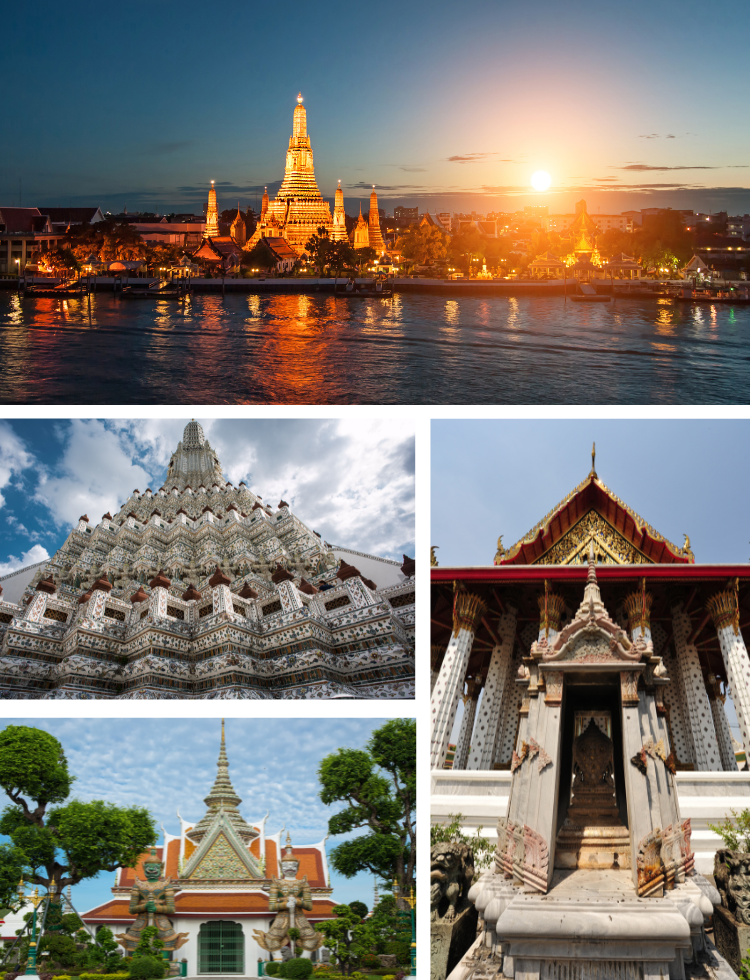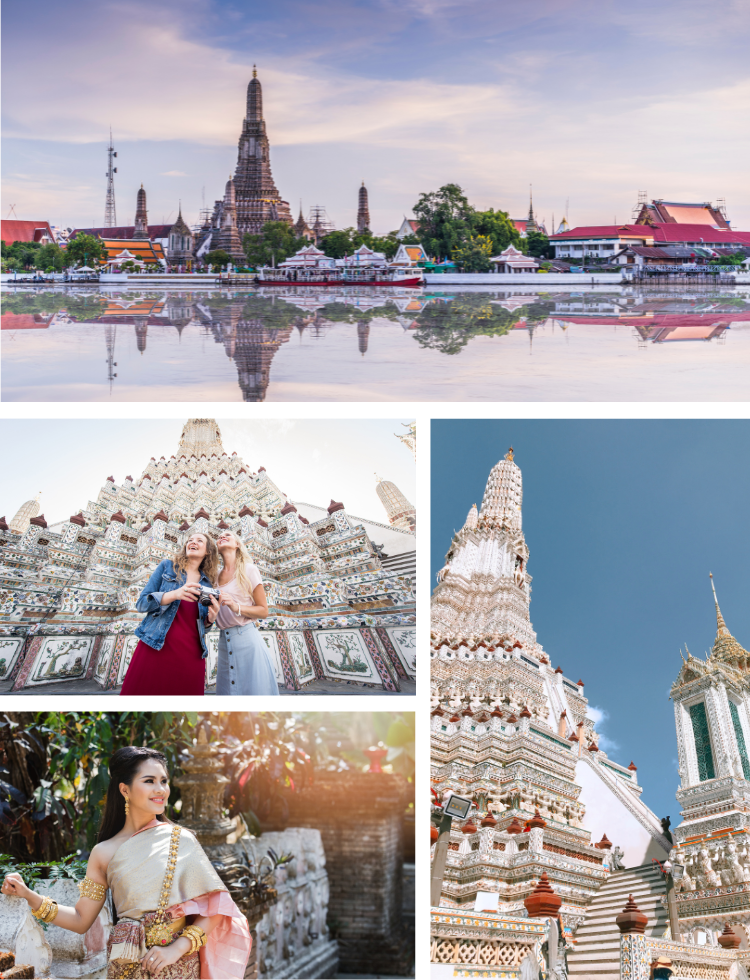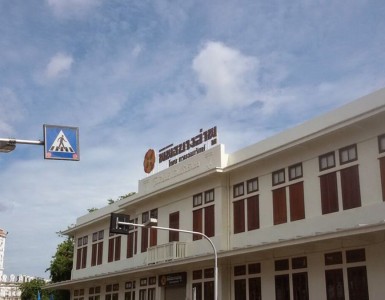Wat Arun (Temple of dawn)
Wat Arun (Temple of Dawn)
Wat Arun or Temple of Dawn is one of Bangkok’s most famous temples west of the Chao Phraya River. It is right next to the Naval Base and directly across Wat Po. It is renowned for both Thais and foreigners due to its decoration’s beauty and signature charm. Every day, thousands of Thais and foreigners visit the temple. Many go there by canal with a tour early in the morning. The best times to view Wat Arun (Temple of Dawn) are at dawn and sunset.
History of Wat Arun

The temple has been at this site since the Ayutthaya Period. Its previous name was Wat Makok. It means Olive Temple. This is because there were many olive orchards in this area. After Burmese armies invaded and conquered the Ayutthaya Kingdom, General Taksin marched his army to conquer it. When he arrived at this temple in the morning, he saw this temple during sunrise.
From that moment, people called this temple Wat Chaeng or Wat Arun. It means Temple of Dawn. When General Taksin became king and moved the Siam capital from Ayutthaya to Thonburi, he appointed Wat Arun as his royal temple. It was inside his residence, the Wang Derm Palace.
During King Taksin’s reign, Wat Arun also housed the Emerald Buddha. Once King Rama I became the king, he established the Grand Palace. So, they also moved the Emerald Buddha from Wat Arun to Wat Phra Kaew as well in 1785. Yet, it remained one of the most important temples in Thailand. Many also use Wat Arun as a logo such as on 10 Baht coins and the logo of the Tourist Authority of Thailand (TAT).
Temple of Dawn Architecture
The main and tallest building of Wat Arun is Phra Prang Wat Arun. It overlooks the Chao Phraya River. It is one of the most famous landmarks in the world and one of the most photographed icons of Thailand. Originally, they built it in the Ayutthaya Period. King Rama II then had it reconstructed and enlarged until finished during King Rama IV’s reign.
He changed its official name to Wat Arun Ratchawararam Ratchawaramahawihan. It is 82 meters tall and became the tallest structure in Bangkok before the modern skyscraper. Phra Prang Wat Arun and its four satellite prangs have colorful porcelain pieces from China as decoration.
Around Phra Prang Wat Arun lie many levels of terraces. Tourists can climb up there to see a nice view of the Chao Phraya River. You will also see the Grand Palace, Wat Pho, and even Bangkok downtown. Apart from this, you can take a look at the main chapel. Also, the hall and the Chinese-style bell tower are very beautiful to watch.
Things to Do in Wat Arun

Visiting Wat Arun offers a variety of experiences for both locals and tourists. Here are some of the activities you can enjoy within the temple complex:
- Climbing Phra Prang: The main attraction is the central prang (tower), where you can climb up steep steps to get a panoramic view of the Chao Phraya River and surrounding landmarks like the Grand Palace and Wat Pho.
- Admiring the Architecture: The intricate details of the temple, especially the colorful porcelain pieces embedded in the prangs, offer a visual feast. Don’t miss the four smaller satellite prangs surrounding the central tower.
- Exploring the Grounds: Take a stroll around the temple grounds. Visit the main chapel (ubosot), the ordination hall, and the Chinese-style bell tower, each with its unique architectural features.
- Photographing the Temple: Wat Arun is one of the most photographed sites in Thailand. The best times for photography are at dawn and sunset when the light enhances the beauty of the temple. Additionally, you can rent traditional Thai costumes to wear while taking photos, adding an authentic cultural touch to your pictures.
- Cultural Performances: Occasionally, the temple hosts traditional Thai cultural performances, including classical music and dance. Check the schedule to see if any events coincide with your visit.
- Meditation and Reflection: The serene environment of Wat Arun makes it an ideal place for meditation and quiet reflection. Find a peaceful spot within the temple grounds to relax and soak in the spiritual atmosphere.
Rules and Dress Code
When visiting the Temple of Dawn, it is important to respect the temple’s rules and adhere to the dress code to ensure a respectful and enjoyable experience while exploring Bangkok culture:
- Dress Modestly: Shoulders and knees must be covered. Avoid wearing sleeveless shirts, shorts, or skirts above the knee. Long pants or skirts and shirts with sleeves are recommended.
- Remove Shoes: You must remove your shoes before entering any of the temple buildings. There are designated areas to leave your shoes.
- Maintain Silence: Keep noise levels to a minimum, especially inside the temple buildings. This helps maintain the serene and respectful atmosphere of the temple.
- No Smoking: Smoking is strictly prohibited within the temple grounds.
- Photography Etiquette: While photography is allowed, avoid using flash inside the temple buildings. Be respectful of worshippers and do not take intrusive photos.
- Follow Signage and Instructions: Pay attention to signs and follow any instructions given by temple staff to ensure a smooth visit.
By following these guidelines, you can help preserve the sanctity of the temple and ensure a positive experience for yourself and others.
How to get to Wat Arun
From Novotel Bangkok Platinum Pratunam, you can walk to BTS Skytrain Chidlom or Siam Station through R-Walk. Then take BTS to Saphan Taksin Station (Silom Line). Leave via Exit 2 and take a Chao Phraya Express Boat to Tien Pier (N8).
After that, take a cross-river ferry to Wat Arun. The ferry boat fare is only 4 Baht per person. It leaves about every 10 to 15 minutes. It operates daily from 6 am until around 8 pm.
- Opening Hours: Daily from 8 am – 6 pm
- Admission Fee: 200 Baht
- Address: 158 Wang Doem Rd, Wat Arun, Bangkok Yai, Bangkok 10600
For more information, call: +66(0)28912185





